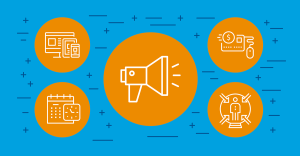According to Salesforce’s Fourth Annual State of Marketing Report, 52 per cent of consumers and 65 percent of business buyers will switch brands if the vendor doesn’t personalize communications. But personalization goes beyond being able to dynamically insert the customer’s name in a marketing email.
Personalization can now involve cookies, IP addresses, platforms, and other metrics about consumers to better provide more accurate information. Below are some ways that personalized marketing can create a better experience for the user.
Website Recommendations Powered by Cookies
When users visit a website they go to regularly, they start to expect a level of personalization. Whether that personalization is listing product recommendations on the homepage that cater to the user’s past browsing history, like Amazon does, or showing a user’s most-read topics front and center as soon as they log into a book retailer’s website, personalized websites can lead to higher engagement and increased return visits.
Web retailers can learn a lot about personalization from Amazon. When users log in, we see book recommendations based on past purchase and browsing history, as well as “Get yourself a little something,” which includes selections from the user’s wish list. The call to action (CTA) of “get yourself something” conveys a feeling of both intimacy, because Amazon knows what users want, and a well-deserved purchase, so customers feel justified in treating themselves.
8 Factors that Should Affect Your Marketing Personalization
- Location – City, country, region
- Device – iPhone, iPad, Android phone/tablet, Windows, Mac, Linux
- Search keywords – Did they arrive while searching for shoes or shirts?
- Visitor frequency – First, second, third, fifth time visitor?
- When they visit – Date and time of day, proximity to payday
- Referring URL – Where did they come from?
- Customer history – Have they bought from you before? What did they buy, and how much did it cost?
- Sessions behaviour – Navigation clicks, page views

Immediately showing content and product recommendations entices consumers and encourages them to take action. In addition to a longer time on site, which is an important metric, users will also be more likely to visit additional pages as recommendations are shown to them.
Change Landing Pages Based on Location
Showing recommendations unique to each user is an important way to personalize marketing. To take it to the next level, Pardot reports that email and landing page campaigns perform better when they are crafted around customers’ time zones and location (based on IP addresses). A MarketingSherpa study cited by Pardot found an eight per cent increase in email open rates when emails were sent out based on users’ time zones and past behaviours. These may vary by industry, but usually, emails sent in the early morning or afternoon may be more likely to be opened, as customers check their email when they wake up and during afternoon lulls. A/B testing email send times can help determine which times most positively affect open rate.
Location can also help brands personalize their marketing. Sites such as Yelp, Groupon, and others automatically display listings and reviews based on the location of the user when they log on. This can create a more seamless experience, as the majority of users are looking for information about their current city.
Optimize for Users’ Devices
Users’ search behaviour can help marketers further guess what consumers look for the most. While Groupon and Yelp suppose that the user is looking for information about businesses immediately nearby, how they access the website can help sites serve more precise information and calls to action.
Mobile internet traffic started surpassing desktop traffic in 2015, which means marketers need to optimize for mobile first. This is especially true because Google is also rolling out a mobile-first search index in 2017 and 2018. Ideally, this means responsive or adaptive websites that automatically resize and reformat based on the user device rank higher than those that aren’t optimized for the mobile experience. Completely separate mobile subdomains are still technically okay, but a responsive website usually has a lot fewer bugs and runs on a central domain.
Furthermore, according to Brafton, long, complicated forms won’t convert on mobile, so stick to CTAs that take a single tap or entry field to complete. This includes “Call Now,” an email signup form, or a link to the user’s default map app with the business address to get directions.
Enhanced Personalized Marketing is Driven by the Customer Experience
- Customers have more control over their experiences with companies.
- Companies are giving their customers control through convenient, self-service solutions.
- By giving customers more control, companies differentiate themselves from their competition.
- The Internet of Things is expanding the buyer journey.
- New products are being developed that help automate aspects of customers’ lives or engage them with their favorite activities.
- Personalized data experiences are popping up in wearables, apps, and other connected systems.
- Artificial Intelligence drives more experiences under the hood.
- AI helps marketers, salespeople, and customer service reps find and help customers faster, in more personalized ways.
- More peer-to-peer models are emerging.
- Popular services like Airbnb and Lyft encourage more peer-to-peer models, especially when combined with crowdsourcing.

Email Funnels Based on History or Personas
Email providers have upped their game, making it easy to create different funnels, lists, and email paths based on a user’s actions or past purchasing history. According to WordStream, when you show users different content based on where they are in the purchasing journey — awareness, interest, consideration, conversion — you can convince them to buy or become invested in your brand.
By offering informative content at the beginning of their journey, and content with more specifics on their purchase toward the end, marketers can guide users and make sure they can more easily find the product or service they need. Along the same lines, you should create different buying funnels for each persona. This can help marketers get even more specific. For instance, if an apparel ecommerce website has different funnels for men’s and women’s socks, they’re more likely to make a sale because the funnels are specifically targeted to different customers. Having content for your sales funnel that includes all customers is better than nothing, but that strategy likely won’t get high conversions or click-through rates.
Customized Messaging Based on How People Find You
Besides their device and the specific searches of each user, narrowing down the information consumers see on your landing pages can be based on how they make their way to your website. For instance, visitors coming from social media may have a different expectation than visitors who clicked on a paid search ad. The messaging used for each different digital platform, including ads, blogs, websites, and social media platforms, is going to vary, and your landing pages should as well.
Use segmentation and create separate landing pages for each channel. In addition to being able to adapt your content to these segmented audiences, you can also track conversions and behavioural metrics more precisely with more specific landing pages. This allows you to A/B test different elements and copy for each channel, which should help increase your conversions.
Statistics Show Your Marketing Needs to be Highly Personalized
- Smart personalization engines that recognize customer intent will enable digital businesses to increase their profits by up to 15%.
- 75% of consumers are more likely to buy from a retailer that:
- Recognizes them by name
- Recommends options based on past purchases, OR
- Knows their purchase history
- 81% of consumers want brands to get to know them and understand when to approach them and when not to.
- 83% of marketers say creating personalized content is their biggest challenge.

Target Related Interests in Ads
Personalizing the audiences you target for advertisements can now be incredibly specific thanks to Facebook, Instagram, and Twitter audience insights. Pardot recommends researching your current customers to look for any commonalities, and then targeting those common interests in search campaigns.
For instance, if the majority of your customers come from a specific zip code, try running an ad campaign just for those areas. Or, if you’ve found that your bait and tackle store customers usually have a boat or enjoy going camping, try running ads with boating and camping interests to see if you can pull in more traffic and conversions.
Some of these target metrics are also common sense. For example, many patrons of hair dye would likely also be interested in makeup, so a beauty supply store could run ads targeting men and women who dye their hair, even if they don’t offer hair dye. Because the ad is about a related interest (makeup), it should pique these customers’ interest to click through and, hopefully, make a purchase.
Giving users a personalized online experience is more than just using their name in marketing materials. By adjusting your website based on their interests and history of interactions, providing them with exclusive emails or information based on their needs, and offering the right CTAs based on how they access your website, you give users a better way to browse the internet.
Called “marketing to a segment of one” by VentureBeat, personalization marketing has become smarter through AI software, which is designed to make online shopping unique for each user. The result is good all around: Customers can more easily find what they are looking for, and brands can earn more conversions, increased repeat purchases, and more time spent by visitors on their websites.
Learn more about what’s to come in marketing in our 2017 State of Marketing Report.
Share “Personalized Marketing is More Than Just a Name” On Your Site



























